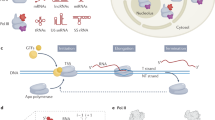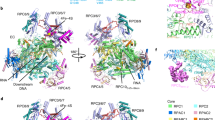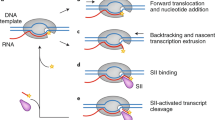Abstract
Transcription of eukaryotic genes is performed by three nuclear RNA polymerases, of which RNA polymerase II is thought to be solely responsible for the synthesis of messenger RNAs1. Here we show that transcription of some mRNAs in humans and rodents is mediated by a previously unknown single-polypeptide nuclear RNA polymerase (spRNAP-IV). spRNAP-IV is expressed from an alternative transcript of the mitochondrial RNA polymerase gene (POLRMT). The spRNAP-IV lacks 262 amino-terminal amino acids of mitochondrial RNA polymerase, including the mitochondrial-targeting signal, and localizes to the nucleus. Transcription by spRNAP-IV is resistant to the RNA polymease II inhibitor α-amanitin but is sensitive to short interfering RNA specific for the POLRMT gene. The promoters for spRNAP-IV differ substantially from those used by RNA polymerase II, do not respond to transcriptional enhancers and contain a common functional sequence motif.
This is a preview of subscription content, access via your institution
Access options
Subscribe to this journal
Receive 51 print issues and online access
$199.00 per year
only $3.90 per issue
Buy this article
- Purchase on Springer Link
- Instant access to full article PDF
Prices may be subject to local taxes which are calculated during checkout




Similar content being viewed by others
References
Lewin, B. Genes VIII 597–626 (Pearson Prentice Hall, New Jersey, 2004)
Kurland, C. G. & Andersson, S. G. Origin and evolution of the mitochondrial proteome. Microbiol. Mol. Biol. Rev. 64, 786–820 (2000)
Gabaldon, T. & Huynen, M. A. Reconstruction of the proto-mitochondrial metabolism. Science 301, 609 (2003)
Masters, B. S., Stohl, L. L. & Clayton, D. A. Yeast mitochondrial RNA polymerase is homologous to those encoded by bacteriophages T3 and T7. Cell 51, 89–99 (1987)
Gray, M. W. & Lang, B. F. Transcription in chloroplasts and mitochondria: a tale of two polymerases. Trends Microbiol. 6, 1–3 (1998)
Tiranti, V. et al. Identification of the gene encoding the human mitochondrial RNA polymerase (h-mtRPOL) by cyberscreening of the Expressed Sequence Tags database. Hum. Mol. Genet. 6, 615–625 (1997)
Taroni, F. & Rosenberg, L. E. The precursor of the biotin-binding subunit of mammalian propionyl-CoA carboxylase can be translocated into mitochondria as apo- or holoprotein. J. Biol. Chem. 266, 13267–13271 (1991)
Seidel-Rogol, B. L. & Shadel, G. S. Modulation of mitochondrial transcription in response to mtDNA depletion and repletion in HeLa cells. Nucleic Acids Res. 30, 1929–1934 (2002)
King, M. P. & Attardi, G. Injection of mitochondria into human cells leads to a rapid replacement of the endogenous mitochondrial DNA. Cell 52, 811–819 (1988)
Smale, S. T. & Kadonaga, J. T. The RNA polymerase II core promoter. Annu. Rev. Biochem. 72, 449–479 (2003)
Paule, M. R. & White, R. J. Survey and summary: transcription by RNA polymerases I and III. Nucleic Acids Res. 28, 1283–1298 (2000)
Matys, V. et al. TRANSFAC: transcriptional regulation, from patterns to profiles. Nucleic Acids Res. 31, 374–378 (2003)
Gossen, M. & Bujard, H. Tight control of gene expression in mammalian cells by tetracycline-responsive promoters. Proc. Natl Acad. Sci. USA 89, 5547–5551 (1992)
Onodera, Y. et al. Plant nuclear RNA polymerase IV mediates siRNA and DNA methylation-dependent heterochromatin formation. Cell 120, 613–622 (2005)
Herr, A. J., Jensen, M. B., Dalmay, T. & Baulcombe, D. C. RNA polymerase IV directs silencing of endogenous DNA. Science 308, 118–120 (2005)
Rantanen, A., Jansson, M., Oldfors, A. & Larsson, N. G. Downregulation of Tfam and mtDNA copy number during mammalian spermatogenesis. Mamm. Genome 12, 787–792 (2001)
Falkenberg, M. et al. Mitochondrial transcription factors B1 and B2 activate transcription of human mtDNA. Nature Genet. 31, 289–294 (2002)
McCulloch, V. & Shadel, G. S. Human mitochondrial transcription factor B1 interacts with the C-terminal activation region of h-mtTFA and stimulates transcription independently of its RNA methyltransferase activity. Mol. Cell. Biol. 23, 5816–5824 (2003)
King, M. P. & Attardi, G. Isolation of human cell lines lacking mitochondrial DNA. Methods Enzymol. 264, 304–313 (1996)
Budanov, A. V., Sablina, A. A., Feinstein, E., Koonin, E. V. & Chumakov, P. M. Regeneration of peroxiredoxins by p53-regulated sestrins, homologs of bacterial AhpD. Science 304, 596–600 (2004)
Pfeifer, A., Ikawa, M., Dayn, Y. & Verma, I. M. Transgenesis by lentiviral vectors: lack of gene silencing in mammalian embryonic stem cells and preimplantation embryos. Proc. Natl Acad. Sci. USA 99, 2140–2145 (2002)
Kaeser, M. D. & Iggo, R. D. Chromatin immunoprecipitation analysis fails to support the latency model for regulation of p53 DNA binding activity in vivo. Proc. Natl Acad. Sci. USA 99, 95–100 (2002)
Harlow, E. & Lane, D. Using Antibodies: A Laboratory Manual 276–301; 103–148 (Cold Spring Harbor Laboratory Press, New York, 1999)
Schuler, G. D., Altschul, S. F. & Lipman, D. J. A workbench for multiple alignment construction and analysis. Proteins 9, 180–190 (1991)
Grundy, W. N., Bailey, T. L. & Elkan, C. P. ParaMEME: a parallel implementation and a web interface for a DNA and protein motif discovery tool. Comput. Appl. Biosci. 12, 303–310 (1996)
Lawrence, C. E. et al. Detecting subtle sequence signals: a Gibbs sampling strategy for multiple alignment. Science 262, 208–214 (1993)
Hertz, G. Z. & Stormo, G. D. Identifying DNA and protein patterns with statistically significant alignments of multiple sequences. Bioinformatics 15, 563–577 (1999)
Keich, U. & Pevzner, P. A. Subtle motifs: defining the limits of motif finding algorithms. Bioinformatics 18, 1382–1390 (2002)
Kel, A. E. et al. MATCH: A tool for searching transcription factor binding sites in DNA sequences. Nucleic Acids Res. 31, 3576–3579 (2003)
Kent, W. J. BLAT–the BLAST-like alignment tool. Genome Res. 12, 656–664 (2002)
Acknowledgements
The work was supported by funds provided by The Lerner Research Institute to P.M.C. and by NIH and RFBR to P.M.C.
Author information
Authors and Affiliations
Corresponding author
Ethics declarations
Competing interests
Reprints and permissions information is available at npg.nature.com/reprintsandpermissions. The authors declare no competing financial interests.
Supplementary information
Supplementary Figures
Supplementary Figures S1-S10 with legends and additional references. (PDF 1417 kb)
Supplementary Notes
Contains Supplementary Methods, Supplementary Table and information on microarray experiment design in MIAME-copliant format. (PDF 68 kb)
Rights and permissions
About this article
Cite this article
Kravchenko, J., Rogozin, I., Koonin, E. et al. Transcription of mammalian messenger RNAs by a nuclear RNA polymerase of mitochondrial origin. Nature 436, 735–739 (2005). https://doi.org/10.1038/nature03848
Received:
Accepted:
Issue Date:
DOI: https://doi.org/10.1038/nature03848
This article is cited by
-
POLRMT mutations impair mitochondrial transcription causing neurological disease
Nature Communications (2021)
-
POLRMT does not transcribe nuclear genes
Nature (2014)
-
Novel classes of non-coding RNAs and cancer
Journal of Translational Medicine (2012)
-
The imprinted Air ncRNA is an atypical RNAPII transcript that evades splicing and escapes nuclear export
The EMBO Journal (2006)
Comments
By submitting a comment you agree to abide by our Terms and Community Guidelines. If you find something abusive or that does not comply with our terms or guidelines please flag it as inappropriate.



